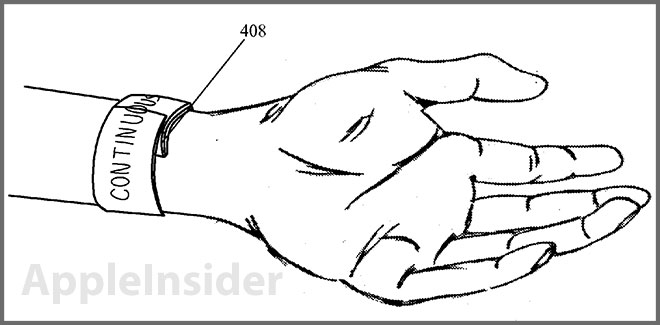Introduction
Apple has consistently been at the forefront of innovation in the wearable computing space, with its iMac, MacBooks, and other devices setting new standards for performance, design, and functionality. However, as wearable technology continues to evolve, so too do the possibilities for Apple’s future products. A newly spotted patent provides a glimpse into one such vision—Apple’s take on what an iWatch might look like if it were to ship as a product.
This article delves into the details of the patent, exploring its design elements, software capabilities, and potential implications for Apple’s wearable lineup. By examining this intellectual property, we can better understand how Apple is pushing the boundaries of what’s possible in smartwatches and other connected devices.
Patent Overview
The patent in question details a wrist-mounted electronic device designed to integrate seamlessly with users’ wrists—a concept that has become increasingly common in modern wearables but was not yet mainstream when Apple first introduced its original iMac in 1984. This design builds on Apple’s legacy of aesthetic minimalism while incorporating innovative features that reflect the current era of technology.
At the heart of the patent is a flexible screen mounted directly on the user’s wrist, resembling a lightweight bracelet. The screen is designed to be foldable and stretchable, allowing for easy interaction with touch or voice commands. This is a significant departure from previous Apple products, which often prioritized portability over display size or durability.
Screen Design
The flexible screen described in the patent is made of a high-precision material that ensures both durability and responsiveness. The design takes inspiration from the eighties’ era of affordable wristwatches, using simple yet elegant shapes to ensure comfort while maintaining functionality.
One of the most notable features of this screen is its ability to track the position of the user’s hand. A series of sensors embedded within the bracelet detect subtle movements and changes in orientation, allowing for precise interaction with apps or devices. For example, users can scroll through a list of messages by gently sliding their wrist forward or backward—a feature that aligns well with the intuitive design principles of Apple’s ecosystem.
Software Functionality
The software capabilities described in the patent suggest a highly integrated experience, blending functionality with aesthetic appeal. One of the most impressive aspects of this iWatch is its ability to manage complex tasks without compromising on user interface.
For instance, users could organize playlists by tapping on different regions of the bracelet while listening to music. Similarly, voice commands could be triggered by subtly moving the wrist in specific directions or patterns. The software also appears to support seamless connectivity with other Apple devices, such as an iPhone or iPad, allowing for shared tasks and real-time collaboration.
Battery Life
One of the most innovative aspects of this iWatch design is its approach to power management. Unlike traditional wearables that rely on bulky batteries, this device incorporates solar panels embedded within the bracelet. These panels generate energy when the user’s wrist is moved, ensuring long-lasting battery life without the need for frequent recharging.
Additionally, the bracelet is designed with kinetic energy in mind, allowing it to detect activity levels and adjust power consumption accordingly. This dual approach to energy management ensures that users can enjoy extended usage without compromising on performance or comfort.
Patent Significance
Apple’s iWatch patent represents a significant step forward in wearable technology, blending aesthetics with functionality in a way that resonates with the brand’s established design philosophy. The bracelet-style screen, combined with its unique software and battery solutions, suggests a product that is both visually stunning and incredibly practical.
This patent also highlights Apple’s commitment to innovation and exploration in the wearables space. By looking ahead to future iterations of iWatches, Apple demonstrates its ability to anticipate trends and push boundaries while maintaining its signature design principles.
Furthermore, the inclusion of advanced sensor technology and integrated software suggests that this iWatch could serve as a precursor to more sophisticated wearables in the near future. Its potential influence on competitors is clear, as other manufacturers may look to mirror or surpass these features in their own products.
Rumors About iWatch
While the patent provides valuable insights into Apple’s future product designs, speculation about whether the iWatch will actually ship remains somewhat premature. However, recent rumors suggest that Apple is actively developing its own line of smartwatches, with several sources indicating potential collaboration with major hardware manufacturers like Qualcomm or Samsung.
These developments could lead to further innovation in wearable technology, with each iteration pushing the boundaries of what’s possible. Whether Apple ultimately opts for a bracelet-style design or another approach remains to be seen. However, one thing is certain: if the patent holds any predictive value, it suggests that the iWatch is on the horizon.
Related Topics
- Apple Products: Explore Apple’s entire lineup and how its designs have evolved over time.
- Smartwatch Trends: Stay updated on the latest developments in wearable technology.
- Wearable Computing: Discover more about the future of connected devices that interact with users’ bodies.
- Innovation in Technology: Keep up with the cutting-edge advancements that define modern tech trends.
Conclusion
Apple’s iWatch patent represents a glimpse into what the future of wearable computing might hold. By combining sleek design with advanced functionality, Apple continues to set the standard for innovation in this space. While it remains unclear whether the iWatch will ship as designed, its potential influence on both hardware and software development is undeniable.
As technology evolves, so too do our expectations—whether it’s in wearables, smartphones, or other connected devices. With companies like Apple leading the way, there’s no limit to what we can achieve when pushing boundaries and redefining possibilities.




